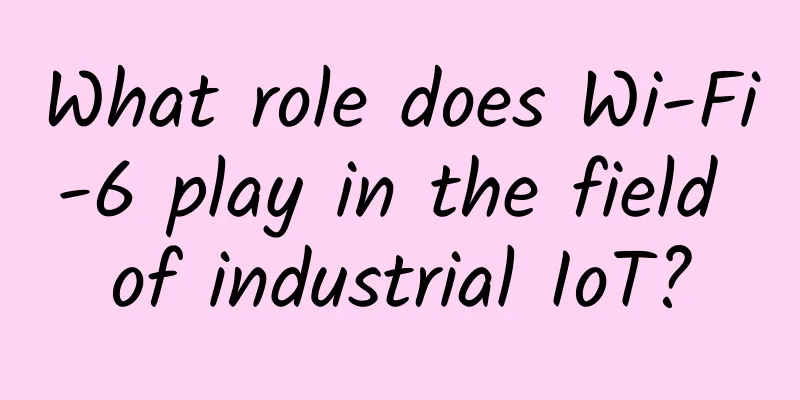What role does Wi-Fi-6 play in the field of industrial IoT?

|
5G technology has enough advantages to support some intensive business needs under the appropriate settings, as well as enable dedicated 5G networks in closed-loop industrial applications. For example, manufacturing and mining industries and other industrial businesses can take advantage of increasingly reliable local private 5G network solutions to manage networked machines throughout the factory floor. More and more smart industries are accepting the operational and cost efficiencies of 5G in edge workflows. Combined with predictive analysis, IoT applications can provide real-time alerts and data collection to provide information for operational and strategic intelligence. According to relevant reports, the industrial IoT market is expected to reach US$344.7 billion by 2026. Industrial IoT sensors can capture and detect a range of variables, from temperature and inventory levels to production output. Likewise, equipment can work in reverse, changing settings to mitigate control and management of industrial machinery. Sensor data fed into predictive algorithms often helps inform machine maintenance schedules, for example, preventing problems from escalating and causing costly downtime. Technologies like robotics, automated production lines, AI-driven predictive maintenance, digital twins, and remote facility control and monitoring are being referred to by the tech media as Industry 4.0. However, it should be noted that manufacturers, engineering organizations, utilities, infrastructure providers, the mining industry, and others have been leveraging the Industrial Internet of Things and, in some cases, Industry 4.0 for about 50 years. 5G networks bring these innovations together in a functional ecosystem, primarily because wireless networks of any color are generally cheaper and faster to deploy than copper or fiber-connected infrastructure over short distances. 5G in particular has a very limited range because it uses very high radio frequencies without multiple relays. Despite the surge in interest in 5G adoption, Wi-Fi remains the most popular wireless technology in industrial environments. Actual IIoT applications including autonomous mobile robots and ground vehicles, equipment sensors, safety control, industrial automotive, location-based services, and WTSN were examined to determine how Wi-Fi 6 and 6E perform to determine whether it will prove to be as viable as 5G or better suited for specific use cases. Real-world Industrial IoT examplesFor AMRs and AGVs, companies have conducted experiments requiring network latency to be between 10-20ms, equipment operating speeds below 50km/h, and network reliability to reach 99.9999%, focusing on safety control applications with latency less than required, such as when operators leave their consoles and the automation system needs to be controlled. An airline has also developed a test platform for Wi-Fi-6 industrial examples to test high-reliability, high-density, and low-power devices. In addition, Wi-Fi-6 has also been studied to achieve a high-resolution frame rate of 90fps in AR/VR applications. This first trial will provide an example for industrial manufacturers around the world who are moving closer to Industry 4.0 to realize the transformation capabilities of Wi-Fi6. Industrial manufacturers work in extremely complex environments, which makes it very difficult to deploy and effectively operate cellular technology. Wi-Fi-6 will play an important role in the 5G ecosystem, enabling a range of cost-effective industrial applications. |
<<: Seize the critical period for large-scale application of 5G
>>: A thought-provoking report on a major communications failure
Recommend
SDN, the new decade, rethinking: the transformation has shown its edge, and the dawn of intelligence is beginning to emerge
Technological innovation remains the most appropr...
Five communication methods between processes required for interviews
Inter-Process Communication (IPC) refers to the t...
OTT IPTV has broad business opportunities. How can operators further explore CDN opportunity windows?
At the Asia-Pacific CDN Summit in April, George, ...
AvenaCloud: €11.5/year - 1GB/10GB SSD/100M unlimited traffic/Moldova complaint-resistant VPS
AvenaCloud is a Moldovan hosting company establis...
IT spending priorities for 2020
The role of the CIO has become a transformational...
The key to moving towards multi-cloud is management tools
Now it has become a consensus that enterprises sh...
"Electricity and telecommunications cooperation" to build 5G is a new interpretation of "speeding up and reducing fees"
"It used to cost 100 yuan for one person to ...
Why does TCP need a three-way handshake? Explain it to you in the most popular words
[[422813]] TCP implementation principle and why t...
Friendhosting 15th Anniversary Promotion: 40% off all VPS, starting from €1.8/month in 13 data centers in the United States, the Netherlands, Japan, etc.
Friendhosting released a promotional email titled...
Finally someone explained the role of OSI and TCP clearly
I have mentioned the OSI reference model and the ...
WebSocket in real-time chat room
To learn more about open source, please visit: ...
RAKsmart: Hot-selling servers, Hong Kong/Korea/Japan/US San Jose dedicated servers starting from $46/month
RAKsmart released information about its promotion...
[11.11]spinservers: $79/month - 2*E5-2630Lv3, 64G memory, 1.6TB SSD hard disk, 10Gbps bandwidth, San Jose data center
spinservers has sent a special promotion during t...
This move can save tens of billions of yuan in 5G construction!
Recently, two major European operators, Vodafone ...









